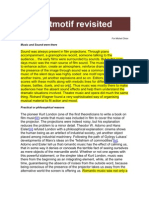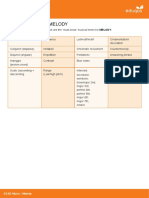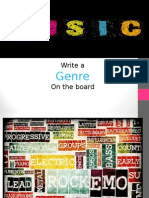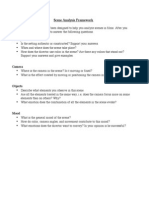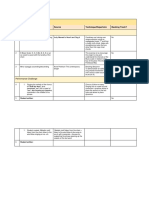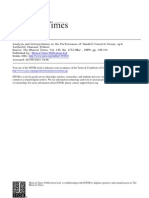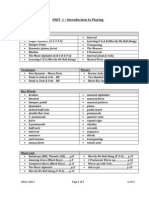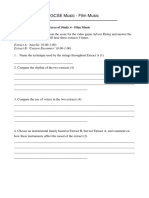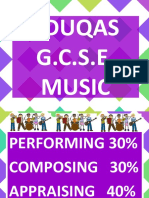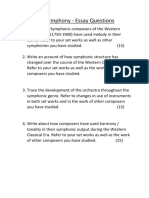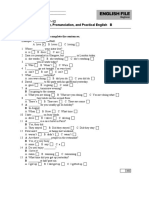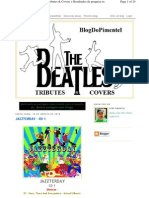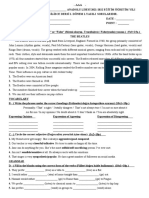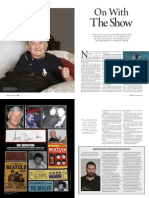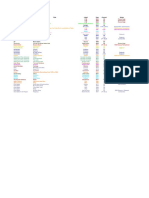0 ratings0% found this document useful (0 votes)
155 viewsBeatles Notes For OCR A2
Beatles Notes For OCR A2
Uploaded by
Sam HorsemanThe Beatles' 1966 album Sgt. Pepper's Lonely Hearts Club Band was a concept album that introduced a fictional band. It was innovative in its musical styles and instrumentation, incorporating classical, folk, blues, and Indian influences. Key songs like "A Day in the Life" and "Lucy in the Sky with Diamonds" featured experimental production techniques like tape manipulation and unusual scales. The album pushed boundaries and represented the peak of the Beatles' studio experimentation.
Copyright:
© All Rights Reserved
Available Formats
Download as DOCX, PDF, TXT or read online from Scribd
Beatles Notes For OCR A2
Beatles Notes For OCR A2
Uploaded by
Sam Horseman0 ratings0% found this document useful (0 votes)
155 views5 pagesThe Beatles' 1966 album Sgt. Pepper's Lonely Hearts Club Band was a concept album that introduced a fictional band. It was innovative in its musical styles and instrumentation, incorporating classical, folk, blues, and Indian influences. Key songs like "A Day in the Life" and "Lucy in the Sky with Diamonds" featured experimental production techniques like tape manipulation and unusual scales. The album pushed boundaries and represented the peak of the Beatles' studio experimentation.
Original Description:
revision notes for OCR A2 music students
Original Title
Beatles Notes for OCR A2
Copyright
© © All Rights Reserved
Available Formats
DOCX, PDF, TXT or read online from Scribd
Share this document
Did you find this document useful?
Is this content inappropriate?
The Beatles' 1966 album Sgt. Pepper's Lonely Hearts Club Band was a concept album that introduced a fictional band. It was innovative in its musical styles and instrumentation, incorporating classical, folk, blues, and Indian influences. Key songs like "A Day in the Life" and "Lucy in the Sky with Diamonds" featured experimental production techniques like tape manipulation and unusual scales. The album pushed boundaries and represented the peak of the Beatles' studio experimentation.
Copyright:
© All Rights Reserved
Available Formats
Download as DOCX, PDF, TXT or read online from Scribd
Download as docx, pdf, or txt
0 ratings0% found this document useful (0 votes)
155 views5 pagesBeatles Notes For OCR A2
Beatles Notes For OCR A2
Uploaded by
Sam HorsemanThe Beatles' 1966 album Sgt. Pepper's Lonely Hearts Club Band was a concept album that introduced a fictional band. It was innovative in its musical styles and instrumentation, incorporating classical, folk, blues, and Indian influences. Key songs like "A Day in the Life" and "Lucy in the Sky with Diamonds" featured experimental production techniques like tape manipulation and unusual scales. The album pushed boundaries and represented the peak of the Beatles' studio experimentation.
Copyright:
© All Rights Reserved
Available Formats
Download as DOCX, PDF, TXT or read online from Scribd
Download as docx, pdf, or txt
You are on page 1of 5
Beatles St.
Peppers Lonely Hearts Club Band (1966)
Facts/Background
The Beatles had massive fame and commercial success from the early 1960s
proved by their 15 no 1 albums. Sergeant Peppers Lonely Hearts Club Band
was one of the most important ever to be produced but it comes from a time
when the publics obsession with the Beatles was beginning to fade. The band
had stopped touring in August 1996 to become studio-based. Sergeant
Pepper was recorded over a 129-day period beginning in December 1966 at
the Abbey Road Studios in London. It was a concept album meaning all songs
are linked by unifying theme in this case a fictitious band who sing about
themes of loneliness/isolation.
John Lennon Vocals, Rhythm Guitar
Paul McCartney Vocals, Bass Guitar
Ringo Starr Drums
George Harrison Lead Guitar
Music
Harmony and Tonality:
-Beatles used both classical and innovative harmony in their songs.
- Circle of fifths used in before the coda in Day in the life.
- Unusual harmony in Being for the Benefit Cm, G+. Bb, Dm augmented chord
gives chromatic colour. But the melody is descending sequence and repetitive to
contour this unusual chord progression.
- Fixing a Hole uses augmented, 6
th
, 7
th
and 9
th
chords largely because of the use
of the blues scale on F in the melody line. This gives the song a heavily blues feel
with prominent Ab and Ebs except on the lines it really doesnt matter,
perhaps showing word painting suggesting that previous melodic trends also no
longer matter.
In fact, the flattening of 6
th
/7ths is a linking harmonic theme on album also
seen in LSD resulting in a chromatic bassline and also in chorus of Help from my
Friends.
- Unusual modulations from Amaj (verse), to Bbmaj (link) and then G
major(chorus) in LSD, although the chorus chords are I, IV and V which is
influenced by traditional chord progressions.
- Unusual time sigs of , 4/4 and 5/4 in Good Morning shows
innovation/invention.
Instrumentation - Album famous for its various instrumentals and influences.
- When Im 64 uses clarinet trio (two Bb clarinets and bass clarinet) to
give music hall effect, also very unusual for pop. McCartneys father was
British music hall performer.
- Strings in Shes leaving home show classical orchestra influence. Vocals
are also falsetto by Lennon in features a rare duet between Lennon and
McCartney. All unusual.
- Extensive use of organs in Being for Benefit shows blues influence and
also helps create the overall effect of a fairground to support the lyrics.
Hammond Organ, Harmonium and Harmonica. The chaos of the
instruments is also supported by the irregular rhythms 2+2+3 irregular
stanza groupings.
- Indian classical instruments show the influence of Indian Classical music
and Ravi Shankar on George Harrisons Within You, Without You. Tabla
plays elaborate rhythmic patterns, Sitar plays a pseudo-improvised solo
with dialogue between instruments. Tambura provides drone on this
track and LSD.
A Day in The Life: the most harrowing song ever written Allan Moore.
Inspired by sad news events in Lennons sections.
-Unusual structure intro, 3 * verses, orchestral crescendo, interpolation, dream
sequence section, 2*verses, orch. Crescendo.
-Diatonic harmony with stepwise bass movement created through chord
inversions.
-Simple melody with limited range panned hard right to reflect the detached
emotional nature of the vocals. Free rhythm again give spoken feeling as if
reading the newspaper. Phrase lengths are very irregular. Finished with
chromatic vocal passages give feeling of instability as we go into the next
section.
-2 orchestral cacophonous crescendo orchestra instructed to improvise within
given range over a certain length of time with dynamics ppp-fff. Shows influence
of aleatoric music favoured by experimental composers. The orch. are double
tracked and played back at slightly different speeds to add depth. The orchestra
are also panned across whole stereo field for depth of sound. Perhaps we could
say that the orchestra represent being transported to another world when the
lyrical content changes so radically between sections.
-Mixylodian mode hints in McCartneys section folk influence. Tempo doubles
to show idea of the manic morning McCartneys lyrics reflect and an alarm clock
sample is added to support the lyrics here. Crotchet piano chords support this.
-Word Painting in dream sequence with lyrical, legato vocalisation representing
a dreamscape because it moves has bigger melodic leaps and much longer
phrases. Slow tempo and sparse texture perhaps represent isolation. Uses ADT
and echo here. Rising circle of 5ths used in dream sequence
Another Verse concerto like piano chords on albert hall to represent the lyrics
reference. In this final verse the left and right channels have been reversed
perhaps signifying that the singers perspective has changed following the dream
sequence?
-Ends on Emaj chord lasts 47 seconds because the stereo masters are boosted
to amplify the natural decay of the sound beyond its normal auditory limits.
Expressive use of technology, suitably epic ending for such an ambitious song.
Being for The Benefit of Mr Kite
- Unusual phrasing because verse 1 has 7 line stanza divided 2+2+3 across
unequal numbers of bars.
- The melody in the verse has descending sequences (traditional device)
but has octave intervals in the last line to represent the acrobatic circus.
Bass becomes more like countermelody as verse progresses.
Rhythm section sounds march like with snare drum rolls reminding the
audience of a tension creating circus drum-roll. Harmonicas and
harmoniums give a circus-like feel to support lyrics.
Henry the Horse Dances a Waltz triggers the waltz section. um paa paa
bass given a chaotic feel rapid descending chromatic scales. Lots of reverb
here to add mystery. Sections ends with dom.7
th
chord of honky tonk
piano. Drums were given high eq boost to make sure they cut through the
timbre of this section.
Fairground samples of calliope organs on tape were cut up, thrown into air
and spliced back together aleatoric influence of experimental and tape
concrete composer, Stockhausen.
Vocals panned right to give a sense of narrative.
Cmin key gives mysterious feel. The use of augmented chords help this too.
Lucy in The Sky With Diamonds
Verse Part A- has very simple melody with even phrase structure and syllabic
crotchet rhythm and use repetition.
Uses inversions and chromatic harmony to produce stepwise bass movement.
First chord = Dmin6/F, unusual in key of A and add harmonic colour to support
colourful, surreal lyrics.
No percussive time keeping supports the dreamlike, free floating lyrics.
Tambura enters on somebody calls you Indian influence.
Verse Part B faster harmonic rhythm. V-1 progression repeated over towering
over your head.
Chorus has higher register and is double time outlines unusual interval of
minor 7
th
with descending repeated quaver melody.
Melisma on word diamonds to represent shimmering?
Tonic/dominant polarity in harmony very standard, influence of traditional
Western harmony.
I-IV-V7 progression is also very functional/traditional this simple harmony
backs up simplistic nature of lyrics here just 3 repeated statements of lucy in
the sky with diamonds very much like repetition in The Kinks - You Really Got
Me. Harmonised on final LintheSwithD to move the song forward also used by
The Kinks.
ADT used on vocal with reverb and phasing to give dream-like quality.
Sergeant Peppers Lonely Hearts Club Band
Use of French Horns shows influence of traditional Western orchestral music
backs up the idea of marching band. Homophonic comping style also backs up
the idea of Sg.Peppers fictitious band. Otherwise, a standard rock track in 4/4
like The Kinks early work.
Pre-recorded audience noises begin the track and help set the scene of a concert
about to take place.
Verse 1 McCartney has a harsh rock timbre like The Kinks.
- Uses repetitive phrases of semiquavers of tonic G and lower chromatic auxiliary
of F# before repeated higher on Bb and A. The Kinks also use simple devices like
ascending sequence Verses of You really Got Me.
- Beatles use lyrics to introduce the band
French Horns represent the trad. marching band when they enter with duet
over the Bridge.
Chorus
lyrics support and introduce the concept album idea.
Syncopated chords under hearts club band to emphasise the theme.
In Gmaj which makes the Bb chords give blues-y feel to lonely again
emphasising the album theme.
Lots of reverb on vocals give impression of a concert hall acoustic
ambience.
Ending introduces Billy Shears and segues into With a Little Help from my
Friends giving feeling of concert.
Influences
The album cover features influential figures including Stockhausen (electro-
acoustic composer who worked with aleatory, as seen in Day in the Life) and
Indian gurus (representing Indian influence in Within You, Without You).
Aleatory (music with element of chance by experimental 60s composers)
Classical instrumentation, (string quartet) harmonic progressions, traditional
structures, tonic dominant relships, diatonic harmony, tonal.
Folk story narratives in songs, refrains in lyrics, accordian,
Blues (organs/blues scale on f fixing a hole/use of modes like blues
scale/chord extensions/
Indian instruments (sitar by George in Withinu and LSD/ravi Shankar taught
George/pseudo improv in WithinU/raga and tabla in WithinU/
British Music Hall compere to introduce songs/clarinet trio 64/Pauls dad BMH
performer.
Technology
George Martin album producer known as 5
th
Beatle because of his input during
recording. Effects like wah-wah pedals and fuzz boxes were also used.
Bouncing Down/Multitrack recording - First album to use 4 track recorder which
meant that errors on single tracks easily replaced. Often these 4 tracks were
bounced down to create single layer on a separate master four track machine.
This made more room for further overdubbing of layers.
Guitar Pedals
ADT Automatic Double Tracking was a machine that allowed for double
tracking without having achieving it manually (a process Lennon hated).
Invented for the album innovation. Uses tape delay to create a copy of an audio
signal that could then be doubled on top. Used on Fixing a Hole to give bass part
a fretless tone. On vocal parts of Within You, Without You. With an additional
flange effect on LSD to give dreamlike quality to vocals.
Segueing Most tracks on the album link seamlessly together, supporting the
idea that all the tracks were linked by united theme of loneliness.
Using non-musical samples to support lyrics features heavily in album. Eg.
Panting and alarm clock in Day in the Life and Animal Sounds in Good Morning
used to increase ferocity as song progresses.
Mics were placed close to audio signal and compressed heavily in Good Morning
to also achieve an aggressive sound.
Panning Beatles are known for separating instruments separately into left and
right fields with panning. For example compere in SG Pepper panned hard left
and then band vocals panned hard right to give impression of separation.
Sounds alongside musical sounds (high pitched sounds and alarm bells to
highlight meaning of lyrics at Day of Life)
You might also like
- Amy Winehouse - Rehab Track AnalysisDocument5 pagesAmy Winehouse - Rehab Track AnalysisSam Horseman100% (1)
- Psycho Wider ListeningDocument1 pagePsycho Wider ListeningSam Hnatiuk100% (1)
- Beatles - HelpDocument3 pagesBeatles - HelpJoe WeisNo ratings yet
- Year 9 Minimalism SOWDocument25 pagesYear 9 Minimalism SOWBlake HarrisNo ratings yet
- Guangdong Yinyue MEP Music NotesDocument4 pagesGuangdong Yinyue MEP Music NotesThomas RettigNo ratings yet
- Vivaldiâ ™s Four Seasons (Spring)Document8 pagesVivaldiâ ™s Four Seasons (Spring)Karen Angela DanaoNo ratings yet
- Release by Afro Celt Sound System Revision SheetsDocument3 pagesRelease by Afro Celt Sound System Revision SheetsCatherineNo ratings yet
- VCE Music Prescribed List Group Works Units 3-4 2019Document58 pagesVCE Music Prescribed List Group Works Units 3-4 2019Nathan PriceNo ratings yet
- Graduate Pre Recital Paper - Geoffrey DeanDocument16 pagesGraduate Pre Recital Paper - Geoffrey DeanGeoffrey DeanNo ratings yet
- Waterloo Sunset - Edexcel NotesDocument5 pagesWaterloo Sunset - Edexcel NotesSam Horseman100% (1)
- The Encyclopedia of Sixties Cool (2007)Document337 pagesThe Encyclopedia of Sixties Cool (2007)lulucf1171% (7)
- Why My Guitar Gently WeepsDocument21 pagesWhy My Guitar Gently WeepsDaya Jala Komunika IINo ratings yet
- Early Beatles Songs PDFDocument43 pagesEarly Beatles Songs PDFRonny Stienen100% (1)
- McCreary RocketeerAnalysisDocument20 pagesMcCreary RocketeerAnalysisDominique MarquerNo ratings yet
- Unit 6 - 44. Jerry GoldsmithDocument8 pagesUnit 6 - 44. Jerry GoldsmithMax WeltonNo ratings yet
- Eduqas 05 Texture Timbre and Dynamics AnswersDocument18 pagesEduqas 05 Texture Timbre and Dynamics AnswersMolly NewtonNo ratings yet
- Eduqas 02 Rhythm AnswersDocument12 pagesEduqas 02 Rhythm AnswersMolly NewtonNo ratings yet
- Rock N RollDocument18 pagesRock N RollMatt GoochNo ratings yet
- MT0317 Scheme KS5 Jazz Primer Part 1Document11 pagesMT0317 Scheme KS5 Jazz Primer Part 1Tracy LegassickNo ratings yet
- Gustavo Costantini: Music and Sound Were ThereDocument11 pagesGustavo Costantini: Music and Sound Were ThereClara MorinNo ratings yet
- Eduqas GCSE Ensemble Reflection BookletDocument21 pagesEduqas GCSE Ensemble Reflection BookletRickiNo ratings yet
- The Concepts of Music Quiz - 2Document51 pagesThe Concepts of Music Quiz - 2api-407999393100% (1)
- Eduqas 01 Melody AnswersDocument14 pagesEduqas 01 Melody AnswersMolly NewtonNo ratings yet
- Unit 6 14 G GabrieliDocument7 pagesUnit 6 14 G GabrieliMax WeltonNo ratings yet
- Overture (Tron Legacy)Document2 pagesOverture (Tron Legacy)ΕΛΛΗΝΕΣ ΚΕΝΤΑΥΡΟΙ ΚΕΡΚΥΡΑΣNo ratings yet
- 10 Mark - Locus IsteDocument1 page10 Mark - Locus IsteojharrisNo ratings yet
- IB Music ReflectionsDocument1 pageIB Music ReflectionsSean WadaNo ratings yet
- Late 1950's To Mid 1970's: by Tom MunnoDocument10 pagesLate 1950's To Mid 1970's: by Tom MunnoMatt GoochNo ratings yet
- LarsonRock 5e Ch1Document26 pagesLarsonRock 5e Ch1codeethyl100% (1)
- Pedal Point - WikipediaDocument10 pagesPedal Point - WikipediaJohn EnglandNo ratings yet
- Mariah CareyDocument2 pagesMariah CareyAileen Umali Carilla-Co50% (2)
- Afro Celt Revision SheetDocument2 pagesAfro Celt Revision SheetRob Williams100% (1)
- Sample Film MusicDocument8 pagesSample Film Musicsimonclarke24No ratings yet
- Songwriter's Monthly Feb. '11, #133 - Laura CheadleDocument5 pagesSongwriter's Monthly Feb. '11, #133 - Laura CheadleSongwritersMonthly100% (1)
- John Williams Star Wars Return of The JediDocument4 pagesJohn Williams Star Wars Return of The JediAirra May Gandia PunzalanNo ratings yet
- The Elements of 20th Century MusicDocument2 pagesThe Elements of 20th Century Musicapi-287736239No ratings yet
- 4b. Conventions of Music Poster GenreDocument26 pages4b. Conventions of Music Poster GenredpagoffsNo ratings yet
- Skyfall Scene Analysis: Sound, Music: Thomas Newman S Score Is Absent Through Out TheDocument2 pagesSkyfall Scene Analysis: Sound, Music: Thomas Newman S Score Is Absent Through Out TheAmir Sanjary ComposerNo ratings yet
- Set Work 8Document1 pageSet Work 8k.k.100% (1)
- Pearson Edexcel Level 1/level 2 GCSE (9-1) in Music: 1MU0/03 2018 Appraising Excerpt TimingsDocument2 pagesPearson Edexcel Level 1/level 2 GCSE (9-1) in Music: 1MU0/03 2018 Appraising Excerpt TimingsYaryna Telenko de OvelarNo ratings yet
- Film MusicDocument3 pagesFilm Musicapi-242279753100% (1)
- Sunken Cathedral Discussion QuestionsDocument2 pagesSunken Cathedral Discussion QuestionsSean K CarpenterNo ratings yet
- Romantic MusicDocument28 pagesRomantic MusicJanette Anne Reyes Macaraig100% (1)
- Calypso Listening TestDocument6 pagesCalypso Listening TestZoeHarrisNo ratings yet
- Instruments of The Orchestra UnitDocument40 pagesInstruments of The Orchestra Unitapi-661316294No ratings yet
- Tsugaru Shamisen: Bachi. The Tsugaru Shamisen Is A Kind of ShamisenDocument1 pageTsugaru Shamisen: Bachi. The Tsugaru Shamisen Is A Kind of ShamisenrenewedNo ratings yet
- Igcse World Music NotesDocument6 pagesIgcse World Music NoteslucosNo ratings yet
- Exercise Template OUTCOME 2 SAC (3) For VCE StudentsDocument8 pagesExercise Template OUTCOME 2 SAC (3) For VCE StudentsJennaNo ratings yet
- Music 1b Final Exam ReviewDocument4 pagesMusic 1b Final Exam ReviewAllen YuanNo ratings yet
- Concert Program AssignmentDocument8 pagesConcert Program Assignmentapi-331312761No ratings yet
- Mark Scheme GCSE MusicDocument18 pagesMark Scheme GCSE Musiczoeage100% (1)
- Variations On A Theme: An Introduction To LeitmotifDocument3 pagesVariations On A Theme: An Introduction To LeitmotifrodrigoaxavierNo ratings yet
- Analysis and Interpretation in The Performance of Handels Concerti Grossi, Op.6Document5 pagesAnalysis and Interpretation in The Performance of Handels Concerti Grossi, Op.6Andrew OlsenNo ratings yet
- Unit 1Document7 pagesUnit 1vcarrollhomeNo ratings yet
- Music Curriculum Key Stage 3Document3 pagesMusic Curriculum Key Stage 3The Desert WandererNo ratings yet
- Exploring Creating Musical Characters Leitmotifs: AND UsingDocument3 pagesExploring Creating Musical Characters Leitmotifs: AND UsingEverson P. Alcantara JuniorNo ratings yet
- 100 Questions - GCSE Edition: NO. DateDocument4 pages100 Questions - GCSE Edition: NO. DateEENo ratings yet
- Film Music Test and AnswersDocument5 pagesFilm Music Test and AnswersZoeHarrisNo ratings yet
- Concert Programs Cantate Domino Bulgaria 2013Document12 pagesConcert Programs Cantate Domino Bulgaria 2013Daniel NeufeldNo ratings yet
- Debussy Revision NotesDocument6 pagesDebussy Revision NotesSam HorsemanNo ratings yet
- Life of Bedrich Smetana and His Influental WorkDocument5 pagesLife of Bedrich Smetana and His Influental WorkAdis 'Reve' JugoNo ratings yet
- Jerry GoldsmithDocument1 pageJerry GoldsmithCinemaQuestNo ratings yet
- Introduction To Eduqas G.C.S.E. MusicDocument15 pagesIntroduction To Eduqas G.C.S.E. MusicRichard PooleNo ratings yet
- Y13 Lesson 2 Vivaldi - Concerto in D Minor, Op AnalysisDocument13 pagesY13 Lesson 2 Vivaldi - Concerto in D Minor, Op AnalysisWilliam WantNo ratings yet
- Belibou 1:2017 SpecialDocument7 pagesBelibou 1:2017 SpecialAlexandra BelibouNo ratings yet
- IVANKA IVANOVA'S SONGS part one: "Pazardzhik Region Bulgarian Folk Songs"From EverandIVANKA IVANOVA'S SONGS part one: "Pazardzhik Region Bulgarian Folk Songs"No ratings yet
- Unit 6 - 46 Barrington Pheloung - Morse On The Case June 2017Document8 pagesUnit 6 - 46 Barrington Pheloung - Morse On The Case June 2017Sam HorsemanNo ratings yet
- Koko Likely Questions!Document1 pageKoko Likely Questions!Sam HorsemanNo ratings yet
- Approaching Long Questions GuideDocument3 pagesApproaching Long Questions GuideSam HorsemanNo ratings yet
- UNIT 3 - 37 Haydn - My Mother Bids Me Bind My Hair June 2017Document5 pagesUNIT 3 - 37 Haydn - My Mother Bids Me Bind My Hair June 2017Sam HorsemanNo ratings yet
- Mendelssohn 4th Movement OverviewDocument3 pagesMendelssohn 4th Movement OverviewSam HorsemanNo ratings yet
- Debussy Revision NotesDocument6 pagesDebussy Revision NotesSam HorsemanNo ratings yet
- The Symphony Essay QuestionsDocument1 pageThe Symphony Essay QuestionsSam HorsemanNo ratings yet
- Harmony Chords and Inversions PresentationsDocument15 pagesHarmony Chords and Inversions PresentationsSam HorsemanNo ratings yet
- Jonah Man JazzDocument1 pageJonah Man JazzSam HorsemanNo ratings yet
- Texture 2Document8 pagesTexture 2Sam HorsemanNo ratings yet
- Les Miserables Full Score 1Document9 pagesLes Miserables Full Score 1Sam Horseman0% (1)
- A Canon of Pop and Rock AlbumsDocument19 pagesA Canon of Pop and Rock Albumsmaggiemcneill100% (1)
- Dear Boy (Acordes para Cancion)Document4 pagesDear Boy (Acordes para Cancion)Rodolfo GuglielmoNo ratings yet
- Hey JudeDocument2 pagesHey JudeAlessandro ParadisoNo ratings yet
- Progress TestDocument10 pagesProgress TestMalena Martinez0% (1)
- The BeatlesDocument24 pagesThe BeatlesElvsPrsly50% (2)
- Rolling Stone - 500 Greatest Albums of All Time - 2012 EditionDocument17 pagesRolling Stone - 500 Greatest Albums of All Time - 2012 EditionAna Karina TurrubiatesNo ratings yet
- The Beatles - Here Comes The SunDocument6 pagesThe Beatles - Here Comes The SunviolinjuanklinNo ratings yet
- And I Love HerDocument1 pageAnd I Love HerTatiana RoveranNo ratings yet
- The Beatles History BootlegsDocument10 pagesThe Beatles History Bootlegsleo_dhNo ratings yet
- Sınıf 1. Yazılı A-BDocument5 pagesSınıf 1. Yazılı A-BSait çınarNo ratings yet
- Hey, Let It Be: John Lennon, Paul Mccartney Arr. R.A.RaberDocument10 pagesHey, Let It Be: John Lennon, Paul Mccartney Arr. R.A.RaberRylieNo ratings yet
- Prestige Magazine Article On SBPDocument2 pagesPrestige Magazine Article On SBPSid Bernstein PresentsNo ratings yet
- MAPEH 10 - Second Quarter - Music - JazzDocument4 pagesMAPEH 10 - Second Quarter - Music - JazzRodolph Ponce100% (1)
- The Beatles and The Art of TambourineDocument22 pagesThe Beatles and The Art of TambourineChiko VadouNo ratings yet
- Blackbird p2 - The Beatles - Guitar Tab PDF - BlackbirdDocument1 pageBlackbird p2 - The Beatles - Guitar Tab PDF - BlackbirdLe Roi KandaNo ratings yet
- Beatles Research Paper ThesisDocument5 pagesBeatles Research Paper ThesisMonique Carr100% (2)
- I'll Follow The SunDocument1 pageI'll Follow The Sunbluesman xNo ratings yet
- If I Ever Get Out of Here by Eric Gansworth ExcerptDocument29 pagesIf I Ever Get Out of Here by Eric Gansworth ExcerptI Read YA100% (1)
- WWW Tracksauction Com John LennonDocument26 pagesWWW Tracksauction Com John LennonJavier galvan perezNo ratings yet
- 1950's, R& R, TV, Counterculture Test Study GuideDocument11 pages1950's, R& R, TV, Counterculture Test Study GuideChad DavisNo ratings yet
- (Free Scores - Com) - Daniel Moretti 60 039 S Hits Medley 74300 PDFDocument8 pages(Free Scores - Com) - Daniel Moretti 60 039 S Hits Medley 74300 PDFВячеслав МариничNo ratings yet
- Something Chords (Ver 2) by Beatles Tabs at Ultimate Guitar ArchiveDocument2 pagesSomething Chords (Ver 2) by Beatles Tabs at Ultimate Guitar ArchivemorbidpaleNo ratings yet
- Cat A LogeDocument2 pagesCat A LogePhil BassNo ratings yet
- Đề ôn thi HSG Tiếng Anh lớp 10 (có đáp án)Document1 pageĐề ôn thi HSG Tiếng Anh lớp 10 (có đáp án)Hong PhanNo ratings yet
- Auslander - Music As Performance 2006Document9 pagesAuslander - Music As Performance 2006Integrante TreceNo ratings yet
- 100 Best Albums of All TimeDocument519 pages100 Best Albums of All TimeNuno Silva100% (2)



















